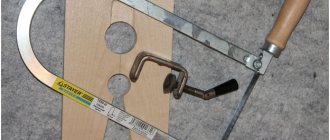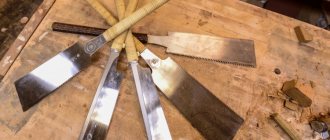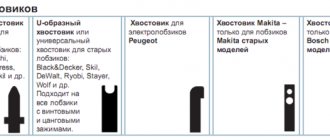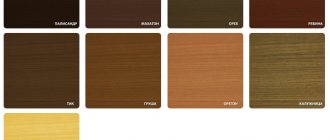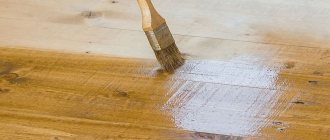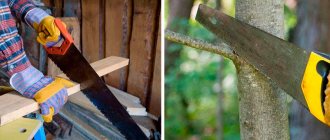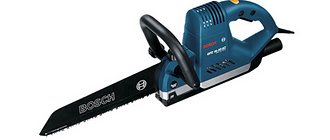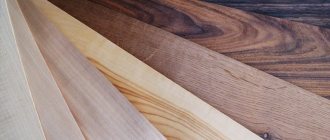When purchasing a jigsaw file at a retail outlet with a salesperson or manager-consultant, it is enough to name the jigsaw model and the material that needs to be cut. A competent salesperson or manager-consultant will select exactly what you need and can give advice on the features of each manufacturer.
When purchasing in a self-service store or online market, the buyer must understand the labeling and quality characteristics of the files themselves. Otherwise, there is a chance of making an unnecessary purchase. Therefore, when buying, you need to know the main points.
Marking of files and its decoding without a table
The difficulty is that there is no unified labeling system in the world. However, many manufacturers try to adhere to the labeling system used by Bosch. And the main marking elements are the same on many products.
The purpose and compatibility of files is determined by color, as well as by digital and letter markings. Often the markings are applied to the shank of the file. There it is not erased during operation, and it will always be possible to determine what material it is intended for. But sometimes markings are placed throughout the canvas. Then, during work, the markings are erased, and the master will have to remember what kind of file it is. The colors mean the following:
- Gray – only for wood.
- Blue is for metal.
- White – for metal and wood.
- Red - for various plastics.
- Black - universal for many materials, specified by additional marking.
A saw for hard materials can be used to cut softer materials, but never vice versa. That is, a metal file can be used to cut wood, but not vice versa. But for effective cutting, you should select a file that is suitable for the material or a universal file.
Compatibility with the jigsaw in terms of the shank shape is important. The most common is the T-shank. As a rule, all such files have a standard shank size that fits all jigsaws. But sometimes there are models, especially old ones, that use saws with different shanks and their markings:
- U stands for U-Shaped Shank.
- M - straight shank with two holes, found on older Makita models.
- F – two crossbars and a straight end.
For the buyer, this marking letter has little meaning, since the shape of the shank is visible at the first glance at the file, even in a picture on the Internet.
The markings begin with these letters T, U and others. For example T101B.
The first number after the letter indicates the saw length group.
- 1 – the shortest files, up to 75 mm long.
- 2 – files of medium length, from 75 to 90 mm.
- 3 – files of increased length, from 90 to 150 mm.
- 4 are the longest, over 150 mm.
Special files with a length of more than 200 are marked with two numbers (the number) 10. In this case, there is a four-digit marking after the letter.
For sawing different materials, saws with different tooth shapes and sizes are used. tooth The last two digits indicate the shape and size of the tooth and its intended use for a particular material.
- 01 – teeth without set, ground to obtain a clean cut.
- 02 – for cutting various plastics.
- 08 – special tooth shape for the cleanest cut.
- 13 – wave-shaped file for soft materials.
- 11 and 19 – wood saws.
- 23 and 24 – files with different shapes and tooth pitches.
- 27 – files for copper, brass, aluminum.
- 41 – saws for sheet building materials – gas silicate (foam concrete), plasterboard, fiber.
- 44 – large tooth with a large set for fast rough sawing of wood.
These numbers are followed by a letter marking - one of the first four letters of the Latin alphabet - A, B, C, D. It indicates the size of the tooth in four main groups. A – the smallest tooth, further enlarged.
As an example, the marking of the T101B file is deciphered as follows:
- T – T-shaped shank.
- 1 – short file, up to 75 mm long.
- 01 – teeth without set, ground to obtain a clean cut.
- B is the second smallest tooth size.
This is the simplest marking. At the beginning it was said that the meaning of the marking may differ among different manufacturers. For example, if after the numbers there are symbols other than A, B, C, D, then the marking does not indicate the tooth size, but the pitch, that is, the distance between the centers of the teeth. Deciphered according to the following table:
- G is the smallest step, up to 1 mm.
- E - pitch from 1.4 mm to 1.5 mm.
- A - step from 1.5mm to 2mm.
- B from 2 mm to 3 mm.
- BC - marking of different (variable) steps, alternating larger and smaller steps.
- C - from 3mm to 4mm.
- D - from 4 to 5 mm.
- X - files with different tooth pitches, increasing towards the end of the blade
- RIFF is a blade with a special fine-grained coating for cutting ceramic tiles.
In addition, the purpose of the file can be simply indicated by an English word. Specifically:
- Wood - used for regular wood.
- Hardwood - for hard wood.
- Alu - the first letters of the name of the metal - aluminum.
- Metal - for ferrous and other metals.
- Inox - specifically for stainless steel.
- Acrylic - for cutting polycarbonate and acrylate materials.
- Fiber&Plaster - for cutting plastics and fiberglass.
- SoftMaterial - for soft sheet materials (linoleum, artificial leather and leather, polystyrene foam, polystyrene foam, etc.)
Sometimes the inscription is in Russian instead of English. For example, just “wood/plastic”.
The grade of steel from which the file is made is important. If the length, shape of the shank, dimensions and pitch of the teeth can be seen and assessed without markings, simply by examining the file, then the grade of steel can be determined solely by markings.
- HCS is a steel with a high carbon content, suitable for cutting soft materials.
- BiM—bimetal (two metals). The use of two different metals increases the strength of the canvas. Bimetal blade can be used for different materials.
- CV is an alloy of chromium and vanadium.
- HSS (high-speed cutter) is the most common tool cutting steel. Used for cutting metal.
- Carbide Technology (CT) or NM - files with a super-hard coating of tungsten carbide, cobalt or artificial diamond powder. They can cut ceramic tiles, finishing bricks, various plastics, asbestos-cement sheets, slate and many other materials.
The metal mark is applied separately from the rest of the markings. Most often, also on the shank, located perpendicular to the rest of the markings. For example, look at the markings of jigsaw files, which are shown in the table below.
Table. Files from Rebir and their compliance with expensive analogues from Bosch.
Types and types of files for jigsaws
Most consumables that are on the market today imply the ability to work with several types of fastenings in power tools. Accordingly, the blades will have several types of shanks.
- T-shank. Sometimes called Boshevsky due to the authorship of its development. It is most widespread, so in fact it can be considered standard.
jigsaw T-shank - U-shaped shank. Historically, it has been most widespread in America, but is also used by a number of manufacturers supplying jigsaws to our country.
U Shaped Jigsaw Blade - Makita shank for discontinued models.
Makita shank for discontinued models - Bosch shank. As in the case of Makita, it is also only necessary for old jigsaws.
Bosch jigsaw blade shank
The last two types are practically never found on the market, since they were used on models of jigsaws that have already been discontinued. There is also a classification according to the size of the canvas:
- length - from 40 to 250 mm;
- in width, which entirely depends on the type of canvas and its purpose. Wide blades are better suited for straight cuts; curved cuts are made with a narrow file;
- by thickness. Thicker blades vibrate less, but please note that thick blades may not fit some devices with quick-release mechanisms. Therefore, before purchasing, you need to ensure compatibility.
Based on the type of materials being cut, blades are divided into the following categories: for wood, for metal, for plastic, and universal.
- For wood and materials of similar density. They are available in three versions: for high-performance cutting, for clean or figured cutting. Saw blades for high-speed sawing have large, widely spaced teeth. For a clean cut, blades with a slight spread and medium-sized teeth are available. Shaped cutting involves sawing along curved lines. Therefore, the blades for this type of carpentry work are short in length and have small teeth. The width of files for figured cutting does not exceed 4 mm.
- For metal. Cutting metal involves significant mechanical stress. Therefore, such canvases are made of especially strong steel. The height of the teeth does not exceed 1 mm.
- For plastic. They have a medium-sized tooth and are interchangeable with saws designed for working with wood for wood.
- For specific tasks. This type includes blades that can be used to cut ceramic tiles or glass. The cutting edges of such blades are coated with carbide or diamond.
In addition, there are universal files. They are capable of cutting all types of materials, but achieving an even cut will be problematic.
Video - Types of jigsaw blade shanks
Classification and features according to the type of material being processed
The modern market offers a large selection of different saws for sawing the same material. They differ in length, shape and size of the tooth, pitch and metal from which they are made. But they belong to the same group, for example, a type of wood saw.
We also recommend reading an interesting article on how to choose a jigsaw; it contains 9 best tips from an expert that will help you make the right choice.
Tree
For this material, you can choose a file with a length from 75 mm to 150 mm.
As a rule, they are all labeled with the word Wood (wood) or Hardwood (hard, hard wood). Different types of files are selected for different tasks.
- A saw with large, sparse teeth, up to 6 mm, will provide a quick rough cut.
- A cleaner cut is made with saws with teeth of about 3 mm.
- For curly cutting along curved lines, a narrow file with a fine tooth, about 2 mm, is suitable.
Laminate
For sawing various laminates, saw blades are selected according to the same principle as for wood. The only difference is that the file must have a medium or fine tooth, designed for laminate, or be universal (wood/plastic).
Metal
An electric jigsaw is rarely used for cutting metal. There are cutting methods that are much more efficient (angle grinders with cutting wheels for metal, hand jigsaws with long files, gas cutters, etc.). However, in some cases it is rational to use a jigsaw with a suitable file.
For example, a long cut with a complex curvilinear shape (rounds and circles, sharp triangles, etc.) cannot be made with a cutting wheel and a hand jigsaw. It is not recommended to use a jigsaw to cut metal thicker than 3 mm, especially black.
Metal files are marked Alu for soft metals or Metal for ferrous metals, galvanized and stainless steel.
Steel grade – high-speed cutter HSS or bimetal BiM.
Plastic
The plastic is sawed off by turning off the pendulum stroke. Files with small and medium teeth of short length are used. Fiber&Plaster marking. For certain types of plastic (PVC), files for hard wood (Hardwood), or universal ones with the inscription “wood/plastic” in Russian or English, are sometimes well suited.
Glass
It is impossible to cut ordinary glass with saws. For this, glass cutters with a diamond wheel are used. You can use saws to cut plexiglass, which is a transparent type of plastic. They also cut it with the same files as plastics (see above).
Ceramics
Ceramics are hard and brittle materials. To cut it, special saw blades with a carbide coating are used, which is much stronger than ceramics. Most often it is tungsten carbide or artificial diamond powder. The file itself is made of ordinary tool steel. The marking of such files is Carbide Technology (CT) or NM. The blade is smooth, without teeth.
Soft materials (rubber)
Universal and special files are suitable for such materials. The first ones should be tried in practice during practical cutting. Rubber, paper and other materials are cut completely differently. Special files are made specifically for a specific material. They can have teeth or be wavy (for cardboard, foam, rubber, etc.). Suitable files may be labeled SoftMaterial or Acrylic.
Universal
There are no absolutely universal files “for all materials”. But often the same files can be used to cut different materials with different densities, structures, viscosities and strengths.
For example, a metal saw can cut wood and plastic. In this case, the file may get stuck in rubber or linoleum due to strong friction and sawdust sticking in the slot . Therefore, the selection of saw blades, even if they are positioned by sellers and manufacturers as universal, is only possible with trial cuts.
Files are often sold in a set that includes files for a variety of materials. This is convenient for users.
- Firstly , there is no need to look separately for special files for different materials.
- Secondly , it is possible to try how the saws will cut different materials. For example, a saw for metal – wood.
Types of files according to purpose
The word jigsaw still evokes associations with wood. And although modern jigsaws are widely used for sawing plastics and metals, the main material for work is still wood and plywood. You also have to think most often about which blades to choose for a jigsaw on wood.
On wood
For general work on wood and its derivatives (plywood, chipboard, MDF), standard saw blades with a gray shank for simple or hard wood are chosen. The dimensions of the blade, the spread and the size of the teeth are selected individually. But sometimes it is necessary to perform work that differs from ordinary sawing.
If speed is important, even at the expense of the quality of the cut, then you need to choose long saws with large teeth and a large pitch. Divorce is also desirable more.
If you need to get an even and smooth cut without chips, then take blades with a small mark or without it at all. Teeth – medium or fine. Materials that have a finishing side (laminate, chipboard) have to be cut upside down. If you want to see the cut from the front side, then you need to choose files with the teeth in the opposite direction (the last letter of the marking is R).
For artistic cutting there should be a narrow blade no wider than 4 mm, small teeth and short length. Compliance with these conditions will allow figure cutting to be carried out at small turning radii.
For metal
An electric jigsaw is still not the most suitable tool for cutting metal. But if necessary, he can handle it if you choose the right file. The teeth of such files are very small and wavy; the blades are made of especially strong alloys, but they also quickly become dull. It is advisable to select files marked specifically for the type of metal you will be working with.
For polymer materials
The file markings contain designations specifically for working with such materials. Ordinary plastic and PVC products can also be sawed with wood blades. In this case, the teeth must be chosen larger and with a larger spread. A small tooth will not only cut, but also melt the material. For plexiglass, it is better to choose a metal fabric with a wavy pattern.
For special materials
These options have their own designation. First of all, it is ceramics. The files for it are made of special alloys, and the teeth are made with a special durable coating.
Also, especially strong coated teeth are required for cutting drywall.
But for soft materials, files without teeth are produced at all. Their cutting edge is a smooth blade, sharpened in a wave-like manner.
Varieties of cutting edge geometry
All files differ in the size of the teeth, the pitch between them and the setting (deviation in different directions).
Milled, classic layout
These are teeth cut out on the canvas by milling with a regular set. One tooth is deviated to the left, the next to the right, etc.
It is called classic or traditional because the teeth on all hand saws, two-handed and sawmill saws, etc. are set in exactly the same way.
With this cut, the cut is wider than the blade. Therefore, clamps are eliminated, sawing is easier, and sawdust ejection is easier.
Milled, wavy layout
It also provides a wider cut than the blade, just like a classic routing. The difference is that the deviation in different directions is not just one for each tooth, but wave-like for several. “Waves” enter the material more smoothly, with less resistance.
Files with wavy layout are used for clean cuts on laminated chipboard, MDF, as well as for cutting metals.
Polished, classic layout
The geometry of the teeth of such files is the same as that of the milled ones described above. The difference is that after cutting and setting, the teeth undergo grinding, during which they are sharpened and acquire a smooth surface. Due to this, friction is reduced and sawing is accelerated, the cut is cleaner, and there are fewer chips of the material.
Conical grinding, without routing
The file has an even row of polished, sharpened teeth. In this case, the shape of the teeth is such that the cut is slightly wider than the blade and without setting. Provide precise, even and neat cuts on various materials.
The main parameters of canvases and what do they affect?
All main parameters are described above. Briefly about what determines each of the main parameters.
Shank types
The shape of the shank must match the model; for example, a file with a U-shaped shank cannot be mounted in a jigsaw designed for T-shaped files.
Sometimes it happens that thick files with a suitable shank do not fit into the fastening groove. This occurs on models with an auto-clamp (without threaded fastening). In such cases, take a thinner file, or slightly sharpen the shank on both sides.
Dimensions
The length of the files is divided into 4 groups from 75 to 150 mm. Each group is marked in the marking with a number from 1 to 4. When selecting the length of the file, proceed from the thickness of the material. At maximum reach, the end of the file should come out of the workpiece.
The longer the file, the more prone it is to move to the side. As a result, the cut may end up crooked. Short, thick files are less prone to bending and cut more accurately.
Saw blades of maximum length - 100-150 mm are used for cutting large-sized wood, soft and light materials such as polystyrene foam.
Tooth shape
Most teeth are shaped like a triangle with sharp corners. Their sizes, layout, and inclination may be different. In addition, there are blades with a wave-shaped cutting edge for soft materials and blades without teeth, with super-hard coating for ceramics, bricks and other hard materials. Here, a layer of diamond chips or tungsten carbide acts as a cutting surface.
Types of shanks
Many owners of jigsaws do not even realize that the structure of the saw holder can be different, since they use one tool. Its type depends on the model of the device and its manufacturer.
Types of fastenings available for jigsaw files:
- T-shaped. This is the most common type found in modern models from Bosch and other manufacturers.
- U-shaped. Mainly present in American instruments. In this case, the saw holder has a screw or collet clamp.
- L-shaped. Found in Peugeot jigsaws.
If you select the wrong shank type, you will not be able to insert the blade into the tool.
How to choose a canvas for a specific task
The file is selected taking into account all the markings described above. (Wood – tree, etc.).
A few more basic rules:
- A short, thick file bends less and moves less to the side.
- A large tooth cuts faster, but rougher.
- A small tooth will tear the surface less.
In addition, to make selection easier, manufacturers sometimes put additional verbal markings on the files:
- basic – basic, standard files,
- speed – speed, fast rough cut,
- clean – thin clean cut,
- progressor - files with floating teeth of different sizes, most often universal,
- flexible – wavy layout for sawing metal,
- special – blades with super-hard coating without teeth for ceramics, some types of plastic, etc.
Which saw to choose for cutting out a tabletop
Countertops made of laminated chipboard and MDF are sawed with saws of sufficient length to cut, but not longer. Long files tend to move to the side. Fine tooth files are used for hard wood (Hardwood) or metal (Alu, Metal).
For quick rough cuts, saw blades with additional speed markings are suitable. A more accurate cut can be made with basic (basic standard) and clean (thin cut) files.
Depending on the characteristics of the material and the jigsaw itself, files can perform differently in their work. A more accurate selection of saw blades is carried out by making trial cuts on an unnecessary piece of material.
For wood
For wood, saws marked Wood (wood) and Hardwood (hard wood) are used. Files with large teeth will provide a quick, rough cut, while files with fine teeth will provide a cleaner and more precise cut.
In some cases, wood is effectively sawed using soft and ferrous metal saws. It is better to cut thick wood with long saws with large teeth. For example, with the marking T344C.
For sawing laminate and chipboard
To avoid chipping surfaces, use fine-tooth files. When sawing, the pendulum motion is turned off. The difficulty is that laminated sheets or slabs are heterogeneous and consist of pressed sawdust, shavings, wood, plywood, coated with laminite.
Laminate is plastic, the base is fiberboard or MDF, in the case of parquet, wood. Therefore, different files are used, including for wood, plastic, soft and ferrous metal. The most effective option is selected by trial sawing on a piece of material.
For figure sawing on wood
For figured cutting, narrow blades with fine teeth are used. The narrow blade allows you to make turns while sawing without breaking, bending or jamming the blade. The fine tooth makes a precise cut and also does not interfere with the rotation of the file when sawing.
For cutting drywall
Drywall, despite its loose structure, is an abrasive material. That is, it is able to quickly grind down the teeth of a saw, for example, on wood. Therefore, special files with a hard coating, straight or wavy, are used for it. As a last resort, files for ferrous metal, but they will not last long, since the plaster quickly wears off the teeth.
For sawing chipboard
For sawing chipboard, short saw blades (up to 75 mm) with a medium tooth (pitch 2-3 mm, marked A or B) are used. Chipboard consists of sawdust and shavings that can easily be cut through by regular wood or hardwood saws.
However, the resins used to glue them together can be harsh, causing the files to wear out quickly. Therefore, for chipboard saws, the quality of the steel is important. Better if it's HSS.
For figured cutting of chipboard, narrow files with a medium tooth are used. For example, T101VO.
For sawing plywood
Plywood can be sawed with wood saws with medium and fine teeth. A large tooth (for quick cutting) tears out pieces of plywood and saws with noise and vibration of the sheet. In practice, plywood is also sawed with fine-tooth metal files. This gives a high-quality, even cut.
Disadvantages: sawing with such files is slower and they can overheat during operation due to friction; clamps are possible due to a small gap. Severe overheating should not be allowed, as this will cause the material to turn black (burn), and the metal of the file may loosen (lose its hardening).
File sizes
Tool holders also vary in length, width and thickness. In the first case, the size can vary between 40-250 mm. For thin material, short files should be used, and for thick tabletops, long ones.
The width of the equipment should be selected depending on the type of work. To obtain an even cut, it is recommended to buy wide files, and, if necessary, a shaped one - thin ones.
The greater the thickness of the equipment, the less it deviates to the side during work.
Important! Thick files are generally not suitable for jigsaws that have a quick-release mechanism.
Rating of the best files for electric jigsaws
Manufacturers of jigsaws are interested in ensuring that their tools work efficiently. Therefore, many brands themselves produce files for electric jigsaws. Moreover, they are suitable not only for the instruments of these brands, but also for others.
Makita and Bosch are considered leaders in quality. In terms of sales and popularity on Yandex.market and other platforms, Makita is the leader. Bosh is in 3-4th positions. But not because of worse quality, but because of a significantly higher price. If a set of 5 files from Makita can be bought for 380-400 rubles, then Bosch files cost from 600 rubles.
Original Bosch files are of high quality.
Hammerflex files are also popular.
What should you pay attention to when choosing first?
The shank must fit the specific tool. If in doubt, you can take the original file that was included in the sales package and visually compare it with what you are supposed to buy.
There must be compliance with the upcoming tasks. The file is selected for the required material and the required length.
When purchasing branded files (Makita, Bosch), it is important to avoid counterfeit products. Unfortunately, when buying in absentia, only a low price can indicate a counterfeit, and not always.
Poor quality is revealed upon closer inspection and operation. A counterfeit product may have unevenly milled or set teeth. Or they are separated only in one direction. The surface of the files is rough, the location and colors of the markings are different.
The quality of steel can only be assessed during operation - weak steel does not cut well.
For hand jigsaws
A hand jigsaw is a specialized tool for small, precise cuts, straight and curved. Files for hand jigsaws are similar to files for electric jigsaws only in that both the first and second saw. Otherwise, these are fundamentally completely different files in all sizes, methods of fastening, shape of teeth, and metal.
The quality of the files determines how well the electric jigsaw will work. Even the highest quality and most expensive jigsaw will not be able to cut well with a bad file. And vice versa, with a good saw, any working jigsaw will cut efficiently. As a result, it is the file that cuts, and the tool itself only guides it and gives it movement.
Therefore, sufficient attention should be paid to the condition of this small-sized consumable part. We also recommend watching a large video - a review about comparing canvases, tests are carried out for curvature, pure cutting and much more, all markings and prices are also given in the video.
